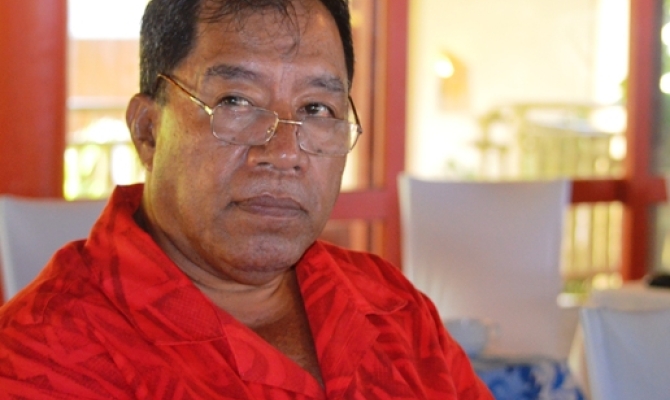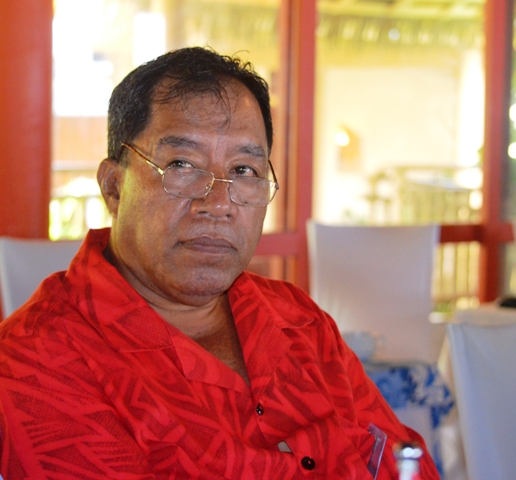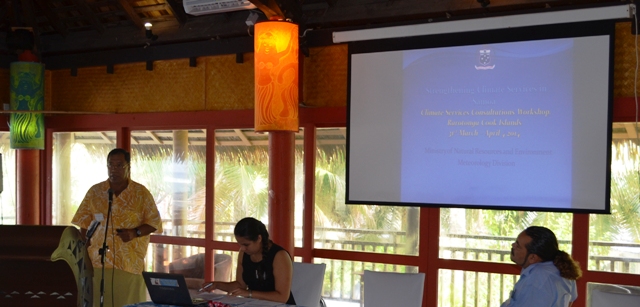
Climate Change Resilience
Meteorological Acronym for today: CLEWS - Climate Early Warning Systems
2 April 2014, Rarotonga, Cook Islands - Samoa is currently seeking funding to continue a four year Climate Early Warning System which began in 2009.
Known as CLEWS, this project enabled the Samoa Meteorology Division to provide sectors with climate forecasts three months in advance. This helped different sectors such as Tourism, Agriculture, Forestry and the Public Health office to be able to plan to prepare for the impacts of the probable climate.

"We provided them with climate forecasts three months ahead so, for farmers, if there was going to be a dry rainfall system they could plan for this, with the public health if a wet rainfall system is expected, they can plan for possible vector born diseases," said Mulipola Ausetalia Titimaea, Director of the Samoa Meteorology Division.
"This really helped our sectors plan and prepare for the effects of different climate systems at least three months in advance. The establishment of the Climate Early Warning System in Samoa was a cross cutting project that saw us work with other sectors who benefited from the advance information."
The four year project was funded from the Least Developed Countries Fund within the Global Environment Facility and was part of a collaboration that had three different components - agriculture; health; and meteorology, for which the Samoa Meteorology Division received just over USD250,000. These funds and the meteorological component of this project were then strengthened with support from other existing projects such as the Pacific-Australia Climate Change Science and Adaptation Planning (PACCSAP) Program, Climate Oceans Support Program for the Pacific (COSPPac) and the Pacific Climate Change Science Program.
When the project first began in Samoa, one of the key challenges was the lack of resources and ability to carry out the necessary analytical work for Climate Early Warning Systems. A range of training and work attachments have since been undertaken to build the skills of Samoa Met staff but there are now new challenges to overcome.
One of these is being able to sustain the project beyond the current funding and Samoa is addressing this through a proposal it will submit to the Global Framework for Climate Services under the World Meteorological Organization.

"The biggest lesson learnt from this is to ensure that there is a sustainability plan in place before the project cycle and funding ends,” says Mulipola.
The proposal to extend the CLEWS in Samoa is one of several to be presented to the Global Framework for Climate Services. There are also plans to extend this service to be able to provide Real Time meteorological information to sectors. There are 40 rainfall stations throughout Samoa, of which 15 are automated so the readings are sent to the main office in real time and the remaining 25 are manually operated, with information from these collected, analysed and shared at the end of each month.
However right now the main priority is to seek support so the CLEWS keep providing tailored information to support the sectors.
Pacific meteorological directors, stakeholders and development partners have come together from 31 March to 4 April in the Cook Islands for the Regional Consultation on Climate Services for Pacific Small Island States and Related Meetings.
2 April 2014, Rarotonga, Cook Islands - Samoa is currently seeking funding to continue a four year Climate Early Warning System which began in 2009.
Known as CLEWS, this project enabled the Samoa Meteorology Division to provide sectors with climate forecasts three months in advance. This helped different sectors such as Tourism, Agriculture, Forestry and the Public Health office to be able to plan to prepare for the impacts of the probable climate.

"We provided them with climate forecasts three months ahead so, for farmers, if there was going to be a dry rainfall system they could plan for this, with the public health if a wet rainfall system is expected, they can plan for possible vector born diseases," said Mulipola Ausetalia Titimaea, Director of the Samoa Meteorology Division.
"This really helped our sectors plan and prepare for the effects of different climate systems at least three months in advance. The establishment of the Climate Early Warning System in Samoa was a cross cutting project that saw us work with other sectors who benefited from the advance information."
The four year project was funded from the Least Developed Countries Fund within the Global Environment Facility and was part of a collaboration that had three different components - agriculture; health; and meteorology, for which the Samoa Meteorology Division received just over USD250,000. These funds and the meteorological component of this project were then strengthened with support from other existing projects such as the Pacific-Australia Climate Change Science and Adaptation Planning (PACCSAP) Program, Climate Oceans Support Program for the Pacific (COSPPac) and the Pacific Climate Change Science Program.
When the project first began in Samoa, one of the key challenges was the lack of resources and ability to carry out the necessary analytical work for Climate Early Warning Systems. A range of training and work attachments have since been undertaken to build the skills of Samoa Met staff but there are now new challenges to overcome.
One of these is being able to sustain the project beyond the current funding and Samoa is addressing this through a proposal it will submit to the Global Framework for Climate Services under the World Meteorological Organization.

"The biggest lesson learnt from this is to ensure that there is a sustainability plan in place before the project cycle and funding ends,” says Mulipola.
The proposal to extend the CLEWS in Samoa is one of several to be presented to the Global Framework for Climate Services. There are also plans to extend this service to be able to provide Real Time meteorological information to sectors. There are 40 rainfall stations throughout Samoa, of which 15 are automated so the readings are sent to the main office in real time and the remaining 25 are manually operated, with information from these collected, analysed and shared at the end of each month.
However right now the main priority is to seek support so the CLEWS keep providing tailored information to support the sectors.
Pacific meteorological directors, stakeholders and development partners have come together from 31 March to 4 April in the Cook Islands for the Regional Consultation on Climate Services for Pacific Small Island States and Related Meetings.